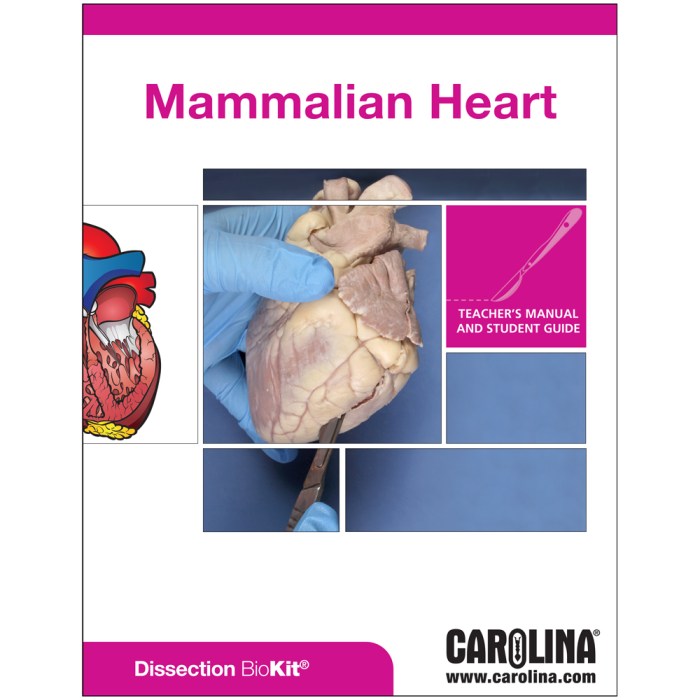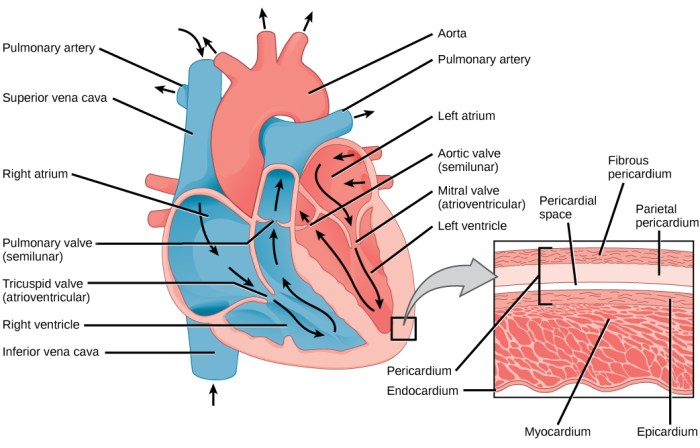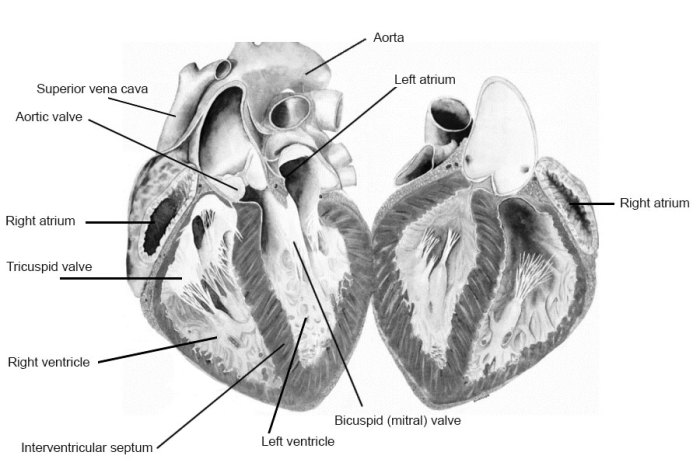Embark on an educational journey with our mammalian heart dissection answer sheet, an indispensable resource that unveils the intricate anatomy and function of this vital organ. Delve into the depths of the mammalian heart, deciphering its chambers, valves, and the intricate symphony of electrical and mechanical events that govern its life-sustaining role.
As we dissect this remarkable organ, we’ll unravel the secrets of blood flow, circulation, and the heart’s unwavering dedication to maintaining life. Prepare to be captivated by the wonders of the mammalian heart, its resilience, and the awe-inspiring processes that keep us alive.
Mammalian Heart Anatomy

The mammalian heart is a muscular organ that pumps blood throughout the body. It is located in the thoracic cavity, between the lungs. The heart is enclosed in a protective sac called the pericardium.
The heart has four chambers: two atria and two ventricles. The atria are the upper chambers, and the ventricles are the lower chambers. The right atrium receives blood from the body, and the left atrium receives blood from the lungs.
The right ventricle pumps blood to the lungs, and the left ventricle pumps blood to the rest of the body.
The heart valves prevent blood from flowing backward. The tricuspid valve is located between the right atrium and right ventricle. The pulmonary valve is located between the right ventricle and pulmonary artery. The mitral valve is located between the left atrium and left ventricle.
The aortic valve is located between the left ventricle and aorta.
The mammalian heart is a complex organ that plays a vital role in maintaining homeostasis. It is responsible for pumping blood throughout the body, providing oxygen and nutrients to the tissues and removing waste products.

Heart Dissection Procedure
A heart dissection is a procedure that allows students to examine the internal structures of the heart. The dissection can be performed on a variety of mammalian hearts, including pig hearts, cow hearts, and sheep hearts.
Before beginning the dissection, it is important to review the safety guidelines and ensure that you have all of the necessary equipment. You will need a scalpel, scissors, forceps, and a dissecting tray.
To begin the dissection, make a cut down the center of the heart. This will expose the four chambers of the heart. The atria are the upper chambers, and the ventricles are the lower chambers. The right atrium receives blood from the body, and the left atrium receives blood from the lungs.
The right ventricle pumps blood to the lungs, and the left ventricle pumps blood to the rest of the body.
Once you have identified the four chambers of the heart, you can begin to examine the valves. The tricuspid valve is located between the right atrium and right ventricle. The pulmonary valve is located between the right ventricle and pulmonary artery.
The mitral valve is located between the left atrium and left ventricle. The aortic valve is located between the left ventricle and aorta.
The heart dissection is a valuable learning experience that allows students to gain a better understanding of the anatomy and function of the heart.
Heart Function
The mammalian heart is a complex organ that plays a vital role in maintaining homeostasis. It is responsible for pumping blood throughout the body, providing oxygen and nutrients to the tissues and removing waste products.
The heart’s function is controlled by a series of electrical and mechanical events. The electrical events begin in the sinoatrial node (SA node), which is located in the right atrium. The SA node generates an electrical impulse that travels through the heart, causing the atria to contract.
The electrical impulse then travels to the atrioventricular node (AV node), which is located between the atria and ventricles. The AV node delays the electrical impulse slightly, allowing the atria to fill with blood before the ventricles contract.
The mechanical events of the cardiac cycle begin with the contraction of the atria. The atria contract, pushing blood into the ventricles. The ventricles then contract, pushing blood out of the heart and into the arteries.
The mammalian heart is a remarkable organ that is capable of pumping blood throughout the body for a lifetime. It is a testament to the complexity and beauty of the human body.
Heart Disorders

Heart disorders are a major cause of death and disability worldwide. The most common heart disorders are coronary artery disease and heart failure.
Coronary artery disease is a condition in which the arteries that supply blood to the heart become narrowed or blocked. This can lead to a heart attack, which occurs when the blood supply to the heart is suddenly cut off.
Heart failure is a condition in which the heart is unable to pump enough blood to meet the body’s needs. This can lead to a variety of symptoms, including shortness of breath, fatigue, and swelling in the legs.
There are a number of risk factors for heart disorders, including high blood pressure, high cholesterol, diabetes, and smoking. It is important to control these risk factors to reduce your risk of developing a heart disorder.
There are a variety of treatments for heart disorders, including medications, surgery, and lifestyle changes. The best treatment for a heart disorder will depend on the individual patient.
Heart Transplantation

Heart transplantation is a surgical procedure in which a damaged heart is replaced with a healthy heart from a donor. Heart transplantation is a major surgery, but it can be life-saving for patients with end-stage heart failure.
The first successful heart transplant was performed in 1967 by Christiaan Barnard. Since then, heart transplantation has become a relatively common procedure. However, it is still a major surgery with a number of risks.
The main risk of heart transplantation is rejection. Rejection occurs when the recipient’s immune system attacks the donor heart. Rejection can be treated with medications, but it can be a serious complication.
Other risks of heart transplantation include infection, bleeding, and blood clots. However, the benefits of heart transplantation often outweigh the risks. Heart transplantation can give patients with end-stage heart failure a new lease on life.
General Inquiries: Mammalian Heart Dissection Answer Sheet
What is the purpose of the mammalian heart dissection answer sheet?
The mammalian heart dissection answer sheet provides a structured guide to assist students and researchers in understanding the anatomy and function of the mammalian heart through a hands-on dissection experience.
What are the key structures and components identified in the mammalian heart dissection answer sheet?
The mammalian heart dissection answer sheet Artikels the external and internal anatomy of the heart, including the chambers (atria and ventricles), valves, blood vessels, and electrical conduction system.
How does the mammalian heart dissection answer sheet facilitate learning about heart function?
The mammalian heart dissection answer sheet guides users through the steps of dissecting a mammalian heart, allowing them to visualize and comprehend the electrical and mechanical events of the cardiac cycle, as well as the heart’s role in maintaining blood flow and circulation.